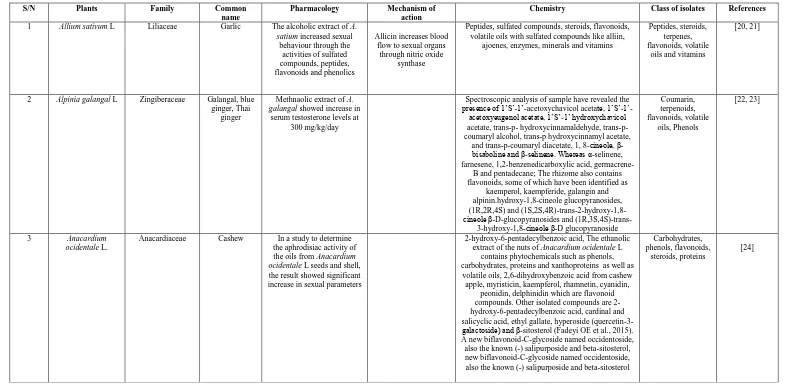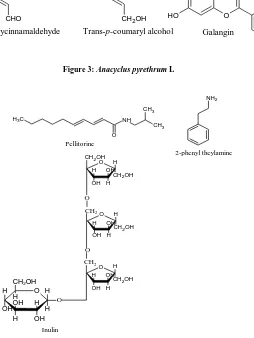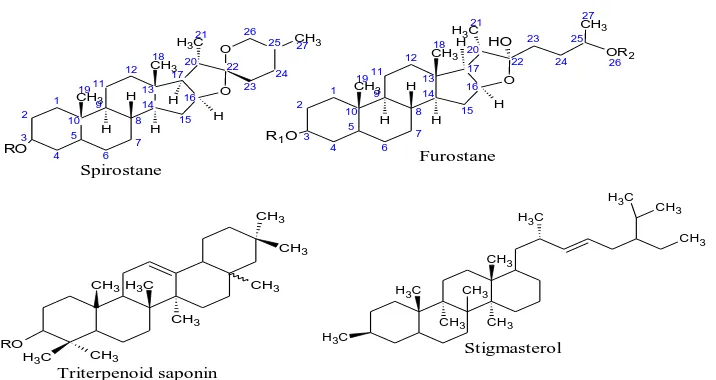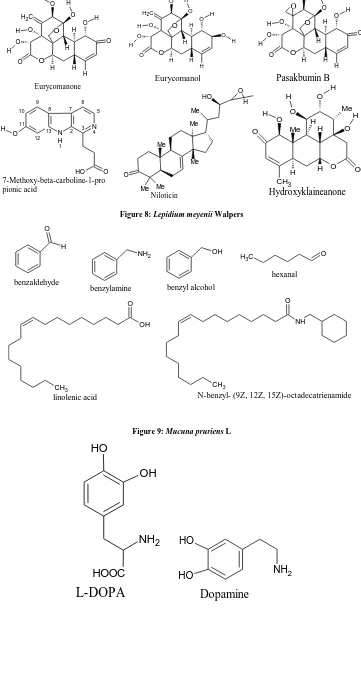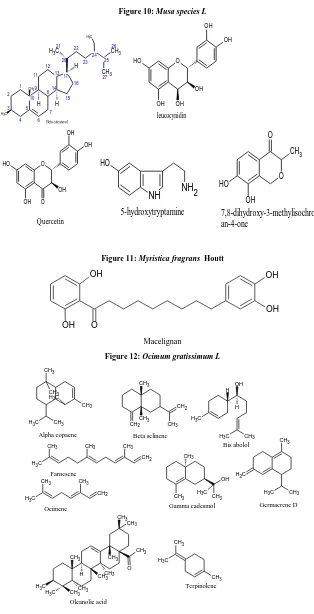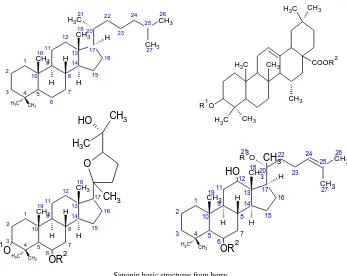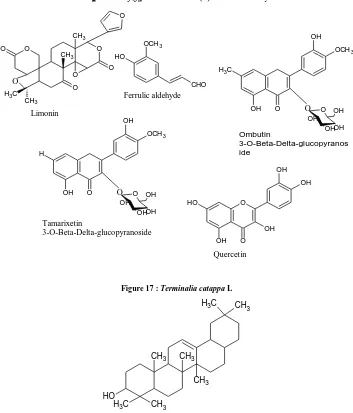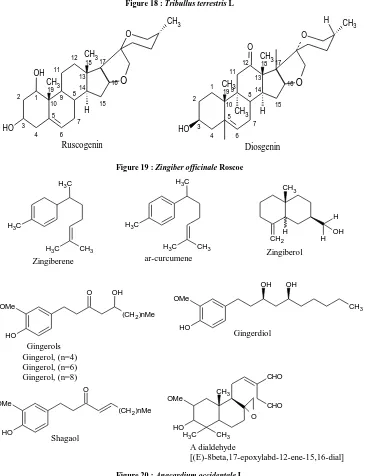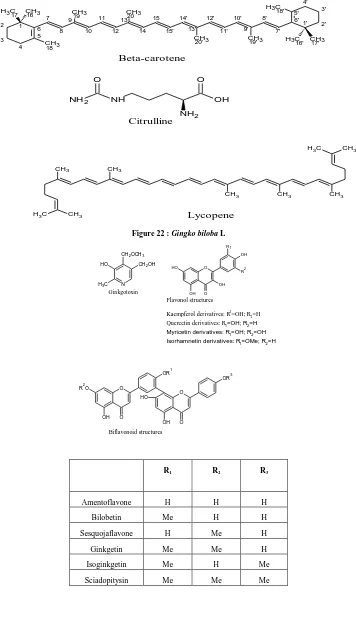Research Article
CODEN(USA) : JCPRC5
ISSN : 0975-7384
70
Chemistry and Pharmacology of Aphrodisiac Plants: A Review
OJ Enema
1, UF Umoh
1, RA Umoh
1, EG Ekpo
1, SK Adesina
1, and OA Eseyin
21
Department of Pharmacognosy and Natural Medicine, Faculty of Pharmacy,
University of Uyo, Uyo, Nigeria.
2
Department of Pharmaceutical and Medicinal Chemistry, Faculty of Pharmacy,
University of Uyo, Uyo, Nigeria.
___________________________________________________________________________
ABSTRACT
Poor sexual performance is a major factor that affects the quality of life. Sexual health requires a positive
approach to human sexuality. Cardiovascular leakages and diabetes are the major factors that are responsible
for poor sexual performance and reproductive health. This review is aimed at reviewing the pharmacological
and phytochemical properties of various medicinal plants used for the improvement of sexual performance and
virility. Psychotherapeutic, pharmacological and traditional methods have been used in the management of
poor sexual performance and virility. Drugs such as papaverin, alprostaldin and stimulants like apomorphine
have been used to improve sexual health. The use of plant such as Panax ginseng C. A. Meyer (Araliaceae),
Cannabis sativa L. (Cannabinaceae), Myristica fragrans Houtt. (Myristaceae), Mucuna pruriens Linn.
(Leguminosae), Chlorophytum borivilianum Santapau & R.R.Fern. (Liliaceae), Eurycoma longifolia Jack
(Simaroubaceae) and Zingiber officinale Roscoe (Zingiberaceae) have been established in the management of
sexual dysfunction. The aphrodisiac activities of plants may be as result of their bioactive constituents. This
research has therefore shown that the reviewed plants can be used for the management of poor sexual
performance and virility.
Keywords:
Sexuality; Aphrodisiacs; Health; Phytochemicals; Virility
_____________________________________________________________________________
INTRODUCTION
71
body releases stress hormones- epinephrine and norepinephrine and this worry or stress is usually created by poor
sexual confidence and fear of not being able to please your partner- the fear of physical intimacy. The production of
these hormones in the body causes poorly wet or dry vagina, highly tense vagina muscles which lead to difficult
penetration or nearly impossible penetration and poor desire for sex [3].
The ability to procreate is enhanced through sound sexual health. Poor sexual performance is a major factor that
must be overcomed for lasting peace in some marriages. Sexuality is a central aspect of being human throughout life
and encompasses sex, gender and roles, sexual orientation, eroticism, pleasure, intimacy and reproduction. Sexuality
is experienced and expressed in thoughts, fantasies, desires, beliefs, attitudes, values, behaviour, practices, roles and
relationships. It is also important to note that while sexuality can include all of these dimensions, not all of them can
be experienced or expressed. Sexuality is influenced by the interaction of biological, social, economic, political,
cultural, ethical, historical, and religious and spiritual factors [4-5]. Sexual health requires a positive and respectful
approach to sexuality and sexual relationships as well as the possibility of having pleasurable and safe sexual
experiences free of coercion, discrimination and violence.
The concept of sexual performance varies from one individual to another. Sexual performance is naturally important
to men due to their ego and instincts to procreate. The ability to satisfy a woman, the size of a man’s penis which is
often though wrongly associated with sexual ability is what makes up every man. Poor sexual performance causes
low self-esteem and due to natural sexual instinct, humans are able to attract suitable mates and procreate. Sexual
performance in male sex is fundamental in the following areas; the ability to satisfy a woman and give her orgasms
and the ability to impregnate a woman [6].
Poor sexual performance can be defined in various ways based on one’s concept of sexual health. The inability to
give a woman an orgasm, inability to erect and sustain and erected penis, premature ejaculation, being selfish
towards your lover’s needs during sexual intercourse, ignoring foreplay, being too uptight during sex which can
make the experience less sensual, routine and boring sex as well as poor communication constitutes poor sexual
performance [7].
Poor sexual performance may also be due to erectile dysfunction which occurs as a result of both physiological and
mental factors. Low sexual desire is expected to be associated with low sexual activity. Like sexual desires, sexual
activity also declines with age. W.H.O estimated over 48.5 million infertile couples worldwide. Poor sexual
performance can be manifested in the first three phases of sex viz; stimulation, the plateau and the climaxing phase.
These manifestations are usually in the form of low libido, painful sex, premature ejaculation, poor lubrication in
women which can hinder pleasurable sex and the inability to achieve orgasm.
According to [8], poor sexual performance can be attributed to numerous factors including hormonal imbalance,
congenital disorders such as micropenis and peyronie’s disease, smoking, excessive alcohols, small penis size or an
excessive penis size, fatigue, stress, performance anxiety, past sexual trauma, age factor and poor body image.
Sound sexual health can be achieved through counseling and sex therapy, medication, and lifestyle changes. Medical
checkups are regularly recommended to ensure it is not due to any untreated medical condition, quitting smoking,
sexual compatibility and regular kergel exercise.
In Ayurveda, poor sexual performance includes a cessation of the sexual desire owing to increased thoughts and
forced intercourse, excessive use of certain substances with pungent, acid or saline taste or heat making articles
which leads to loss of Saumya Dhatu (watery principle) of the organism, virile impotency resulting from inadequate
semen in persons addicted to excessive sexual pleasure, diseases such as syphilis, Sahaja impotency (congenital or
sexual incapacity from birth), voluntary suppression of the sexual desire by a strong man observing perfect
continence and impotency due to the destruction of local Marma (spermatic cord) [9].
Male impotence or erectile dysfunction is caused mainly by cardiovascular leakages and diabetes among other
factors and the use of plants or plant based products to stimulate sexual desire and to enhance performance and
enjoyment is almost as old as human race itself. Androgens play significant role in male reproductive health as it
acts centrally and peripherally during initiation and sexual intercourse. Stimuli such as steroids (testosterone) are
known to either upregulate or downregulate androgen response [10]. Treatment of erectile dysfunction may involve
psychotherapeutic approach and pharmacotherapy using drugs such as papaverin, alprostadil, vardenafil and central
stimulants like apomorphine or herbal drugs with aphrodisiac activity [11].
72
Aphrodisiac Plants
The term ‘aphrodisiac’ was derived from the Greek word ‘aphrodite’ which represents a symbol of love and beauty.
Over the years, a large number of natural remedies have played different roles as aphrodisiacs in different cultures
and civilizations. There is a natural interest of human beings for substances that stimulate libido, potency, virility,
and sexual pleasure as it takes care of sexual desires, ejaculation, orgasm and erectile dysfunction. An aphrodisiac
literally includes substances that have played significant roles in the management of sexual dysfunction and which
also improves sexual behaviour and satisfaction in humans and other animals [12].
According to Ayurveda, aphrodisiacs are classified in the following categories; drugs which increase the quantity of
semen or stimulate the production of semen such as
Microstylis wallichii
,
Roscoea procera
,
Polygonatum
verticillatum
,
Mucuna pruriens
and
Asparagus racemosus
, drugs which purify and improve the quality of semen for
example,
Saussurea lappa
,
Myrica nagi
,
Sesamum indicum
,
Vetiveria zizanoides
and
Anthocephalus cadamba
, drugs
which improve ejaculatory functions for example,
Strychnos nux vomica
,
Cannabis sativa
,
Myristica fragrans
and
Cassia occidentalis
, drugs delaying the time of ejaculation or improving ejaculatory performance such as
Sida
cordifolia
,
Asparagus racemosus
,
Cinnamomum tamala
,
Anacyclus pyrethrum
,
Mucuna pruriens
and
Cannabis
sativum
, drugs arousing sexual desire, namely.
Withania somnifera
,
Asparagus rcaemosus
,
Datura stramonium
,
Anacyclus pyrethrum
,
Hibiscus abelmoschus
and opium [13](Table 1).
The use of plant based products to stimulate sexual desires and enhance performance and pleasure is almost as old as
human race itself since man cannot alienate self from using plants and plant based products for the treatment of his
ailments. Aphrodisiacs are basically grouped into two; psychophysiological stimuli (visual, tactile, olfactory and
aural) preparations and internal preparations such as food, alcoholic drinks and love portion. Aphrodisiacs can also
be categorized based on their mode of action into three groups; substances that increase libido (sexual desire and
arousal), substances that increase sexual potency (effectiveness of erection) and substances that increase sexual
pleasure [14].
From a scientific standpoint, many historically “powerful” aphrodisiacs may have had such strong results due to
mere belief or their powers by users, while nowadays, because of science, many foods are considered to be helpful
in your sex life because of the nutrients, vitamins and minerals which they contain. Many herbs have been
scientifically proven to increase sexual desire and much more. Plants which possess ability to boost sexual
performance and virility include the following; Almonds, Asparagus, Avocado, Banana, Coconut, Dates, Garlic,
Mango, Mushroom, Olive, Onion, Sesame seeds, Parsely, Wheat grass, Mints, Aloe, and Celery among others [15].
Apart from medicinal plants, several other drugs of metal and mineral origin are also described in ayurveda for their
spermatogenic and virility activities. These include varatika (calcium), gold, etc, Animal products such as meat soup
of cock, peacock, swan or sparrow; semen of crocodile, etc. have been reported to possess aphrodisiac activity [16]
(Figure 1-10).
Mechanism of action of aphrodisiac plants
Penile erection is controlled by the balance between the factors leading to the contraction and relaxation of smooth
muscles of the corpus cavernosa, these effects may occur directly on the central nervous system and/or on the
peripheral nervous system by the alteration of blood flow to the genitalia. Neurochemical systems such as
norepinephrine, dopamine, serotonin, acetylcholine and histamine work together for increase in sexual arousal.
There are different mechanisms of action of aphrodisiacs such as nitric oxide (NO)-based mechanism of action and
androgen based mechanism of action. The neurotransmitter NO drives the relaxation of the penile vasculature and
trabecular smooth muscles which play significant roles in penile erection. Relaxation of the trabecular smooth
muscles of the corpus cavernous leads to decreased vascular resistance and increased blood flow to the penis. A
decrease on outflow is ensurd by the compression of the subtunical venules. Both increased inflow and decreased
outflow results to penile engorgement and erection. Vasolidation is mediated by NO from the vascular endothelium
of the sinusoids and nonadrenergic, noncholinergic and cavernosal nerves (Figure 10-20).
73
Table 1:Medicinal Plants used for the improvement of sexual performance and virility
S/N Plants Family Common
name
Pharmacology Mechanism of action
Chemistry Class of isolates References
1 Allium sativum L Liliaceae Garlic The alcoholic extract of A. satium increased sexual
behaviour through the activities of sulfated compounds, peptides, flavonoids and phenolics
Allicin increases blood flow to sexual organs
through nitric oxide synthase
Peptides, sulfated compounds, steroids, flavonoids, volatile oils with sulfated compounds like alliin,
ajoenes, enzymes, minerals and vitamins
Peptides, steroids, terpenes, flavonoids, volatile
oils and vitamins
[20, 21]
2 Alpinia galangal L Zingiberaceae Galangal, blue ginger, Thai
ginger
Methnaolic extract of A. galangal showed increase in
serum testosterone levels at 300 mg/kg/day
Spectroscopic analysis of sample have revealed the presence of acetoxychavicol acetate,
1’S’-1’-acetoxyeugenol acetate, 1’S’-1’ hydroxychavicol acetate, hydroxycinnamaldehyde, trans-p-coumaryl alcohol, trans-p hydroxycinnamyl acetate,
and trans-p-coumaryl diacetate, 1, 8-cineole, β-bisaboline and β-selinene. Whereas α-selinene, farnesene, 1,2-benzenedicarboxylic acid, germacrene-
B and pentadecane; The rhizome also contains flavonoids, some of which have been identified as
kaemperol, kaempferide, galangin and alpinin.hydroxy-1,8-cineole glucopyranosides, (1R,2R,4S) and (1S,2S,4R)-trans-2-hydroxy-1,8-cineole β-D-glucopyranosides and
(1R,3S,4S)-trans-3-hydroxy-1,8-cineole β-D glucopyranoside
Coumarin, terpenoids, flavonoids, volatile
oils, Phenols
[22, 23]
3 Anacardium ocidentale L.
Anacardiaceae Cashew In a study to determine
the aphrodisiac activity of the oils from Anacardium ocidentale L seeds and shell, the result showed significant increase in sexual parameters
2-hydroxy-6-pentadecylbenzoic acid, The ethanolic extract of the nuts of Anacardium ocidentale L
contains phytochemicals such as phenols, carbohydrates, proteins and xanthoproteins as well as
volatile oils, 2,6-dihydroxybenzoic acid from cashew apple, myristicin, kaempferol, rhamnetin, cyanidin,
peonidin, delphinidin which are flavonoid compounds. Other isolated compounds are 2-hydroxy-6-pentadecylbenzoic acid, cardinal and salicyclic acid, ethyl gallate, hyperoside (quercetin-3-galactoside) and β-sitosterol (Fadeyi OE et al., 2015). A new biflavonoid-C-glycoside named occidentoside, also the known (-) salipurposide and beta-sitosterol, new biflavonoid-C-glycoside named occidentoside, also the known (-) salipurposide and beta-sitosterol
Carbohydrates, phenols, flavonoids,
steroids, proteins
74
S/N Plants Family Common
name
Pharmacology Mechanism of action
Chemistry Class of isolates References
4 Anacyclus pyrethrum L
Asteraceae Arkakara Administration of 50 mg/kg
and 100 mg/kg of aqueous extract in albino rats showed
significant anabolic and spermatogenic effects. In a
separate study, petroleum ether extract had marked nfluence on body weight and
accessory sexual organs weight as compared with
arachis oil
This could be partly explained by its vasorelaxant properties
which may be caused by an increase in NO production in vascular
bed and a decrease in its destruction
Alkyl amides, pyrethrins, inulin, sesamine, hydrocaroline, pellitorine, volatile oils such as It is also composed of 2-phenyl ethylamine, anacylin, β-biotol, salvia-4 (14)-en-1-one. Eudesma-4(15),7-diene-1-ol and β-himachalol; the essential oil also contains germacreme D,
germacreme-4(15),5,10(14)-trien-1-a-ol, caryophyllene oxide, cedryl acetate, eudesma-4(15),7- diene-1-β-ol and spathuleno
Amides, Volatile oils
[25-27]
5 Butea frondosa L Papillionaceae Flame of the Forest, Bastard
Teak, Parrot Tree
The extract (400 mg/kg body wt./day) was administered orally by gavage for 28 days.
Mount latency (ML), intromission latency (IL),
ejaculation latency (EL), mounting frequency (MF), intromission frequency (IF),
ejaculation frequency (EF) and post-ejaculatory interval
(PEI) were the parameters observed before and during the sexual behavior study at day 0, 7, 10, 14, 21, and 28.
The extract reduced significantly ML, IL, EL and
PEI (p < 0.05). The extract also increased significantly MF, IF and EF (p < 0.05). These effects were observed
in sexually active and inactive male rats.
Fixed oil 18 %, Water soluble albuminoid substances 19% and glucose 6 %. Fatty acids isolated from this
oil are orleic l
inoleic, lenorlenic, palmitic, stearic, arachidic, behenic and lingo cleric acid. Q hydroxy-1-methyo allophonic acid, 15-hydroxy pentasonic acid and 1-carboxy methoxy-2-1-carboxy hydrazine have been isolated from the seed coat. Seed has shown the presence of alkaloid monspermine from the alcoholic
extract of the seeds are identified palasonin & palasonin-N-Phenyl imidine. Aqueous methanolic
extract contains a triazine compound, 4-carbo-methoxy-3-dioxo-hydro-1,2,4-triazine
4.Carboxymethoxy 3.6 dioxo hydro 1, 2, 4, triazine
Amino acids, alkaloids, fixed oils
75
S/N Plants Family Common
name
Pharmacology Mechanism of action
Chemistry Class of isolates References
6 Caesalpinia benthamiana (Baill)
Herend α Zarucchi
Fabaceae Caesalpinia The methanolic extract
exhibited an accelerator effect by decreasing the latent time. The oral administration of aqueous
extract of Caesalpinia benthamiana showed significant increase in mounting frequency and intromission frequency at the
dosage of 50 mg/kg
The petroleum ether exract of the bark have yielded cassane diterpenes with antibacterial activity such as
deoxycaesaldekarine C, benthaminine I and benthaminine 2, The aqueous extract contains flavoinoids, phenols, anthraquinones such as gallic
acid, resveratrol; the chloroform and n-butanol extract contains methyl gallate, shikimic acid-3-O-gallate, 1-O-methyl-D-chiroinositol, (-)-epicatechin,
(-)-epictaechin-3-O-gallate and kaempferol-3-(6’’-galloyl) glucoside.
Terpenes, benthamine, fatty acids, flavonoids,
alkaloids
[29]
7 Cannabis sativa L Cannabinaceae Marijuana, hemp
In India’s ayurveda and Chinese unani medicine, Cannabisis used to overcome
impotence and raise libido and as a general cure for the
disease.
Narcortic resin, cannabidiol, cannabidiol-carboxylic acid, cannabigerol and cannabichromene, cannabipinol and cannabidivarin, phloroglucinol
β-D-glucoside, tetrahyrocannabinol,
Cannabinoids, Phenol, alkaloid, flavonoid, volatile
oils
[30]
8 Chlorophylum borivilianum
Santapau & R.R. Fern
Liliaceae Safed Musli In a study of the aqueous
extract of dried roots of Safed Musli in rats, there was increase in libido, sexual
vigour and sexual arousal at 250 mg/kg. The sudy supported treatment of premature ejaculation and
oligospermia
The chemical structure of stigmasterol is
related to that of testosterone and mainly
contributes to its aphrodisiac potentials;
hecogenin produces anabolic hormone
Isolated compounds include stigmasterol and hecogenin which are responsible for its antioxidant
power, anticancer and aphrodisiac activities. Chlorophytoside-1, fatty acids, eicosadienoic
glycosides, saponins, fatty acids, hydrocarbons
76
S/N Plants Family Common
name
Pharmacology Mechanism of action
Chemistry Class of isolates References
9 Citrulllus lanatus (Thunb.) Matsum. & Nakai
Cucurbitaceae Water
Melon
The effect of red watermelon flesh extract on male sexual
behaviour has been determined. In the research,
the suspension of the flesh extract was administered on
doses 100, 500 and 1000 mg/kg to different groups of
male rats (n=5) daily for 22 days. The result showed that
oral administration of watermelon flesh extract caused significant increase in
mounting frequency, intromission frequency and
ejaculatory latency. Watermelon flesh extract did not produce undesirable side effects on the male rats and
thus its short term use is apparently safe
Citrulline improves blood drive to the genital regions and plays a significant role
in the relaxation of blood, a major tool in
high sexual performance
Watermelon contains bioactive agents such as citrulline, β-carotene and lycopene which have been
used in the management of prostate cancer.
Carotenoids [33]
10 Eurycoma longifolia Jack
Simaroubaceae Tonkat Ali Standardized extract F2 at 25
mg/kg and its quassinoids improved rat spermatogenesis, improved testosterone steroidgenesis. standardised water extract at 400 mg/day for six weeks on testosterone, epitestosterone
(T:E) ratio showed significant difference between supplementation and placebo. Treatment with
Tongkat Ali extract at 400 mg/day for 5 weeks resulted
to increase in free and total testos terone concentration and muscular force in men
and women
Improves spermatogenesis by
affecting the hypothalamic-pituary-gonadal axis. Improves
testosterone by inhibiting aromatic
conversion of testosterone to ostrogen
and may also involve phosphodiestrase inhibition. The extracts
of tongkat Ali affects male infertility by suppressing α-2HS glycoprotein expression which thereby increases testosterone level and
insulin sensitivity
Quassinoids such as eurycomanone, eurycomnol, pasakbumin-B, hydroxylklaineanones, β-carboline alkaloids, canthin-6-one alkaloids, eurycomalactone,
laurycolactone, biphenyl neolignan and steroids, alkaloids such as 5,9-dimethoxycycanthin-6-one, 9,10-dimethoxy-3-methylcanthin5,6-dione have been
reported. Squalene derivatives such as longilene peroxidase, teurilene, eurylene and 14-deacetylleurylene have also been isolated
phenols, quassinoids, alkaloids, volatile oils, hydrocarbons
77
S/N Plants Family Common
name
Pharmacology Mechanism of action
Chemistry Class of isolates References
11 Ginkgo biloba L. Ginkgoaceae Gingko According to some researches, extracts of
Ginkgo biloba may also help in psychological conditions
by easing stress, mild depression and anxiety- major causes of poor sexual
performance thereby improving the mood for sexual pleasure. Ginkgo biloba extract have been used in traditional Chinese medicine to improve blood circulation. Ginkgo biloba
constituents have a thinning effect on the blood besides helping to improve the muscle tone in the walls of
the blood vessels
Improved blood circulation results to an
increase in the amount of oxygen in the blood and to all major organs of the body including
the heart and brain thereby resulting to an
increased arterial inflow to arterial tissues
through arteries and veins without obstructing systemic blood pressure. This enhanced supply of blood to sex organs is crucial in maintaining
strong erection
GC-MS, HPLC-MS, HPLC-RI analysis of samples have led to the characterization of ginkgolides A, B,
C, J, M with cage structures involving a tertiary butylgroup and six membered rings including a
spiro-nonane system, a tetrahydrofuran and three lactone groups. 33 flavonoids have been isolated from the
leaves including amento flavone, quercetin, myricetin, sesquojaflavone, Ginkgetin, Isorhamnetin,
etc. Ginkgolic acids have also been isolated; the albumen of the seed also contains neurotoxic
4’-O-methylpyridoxine (ginkgotoxin), etc
Steroids, flavonoid, ginkgosides
[41]
12 Hibiscus sabdariffa
L. (Hs)
Malvaceae Zobo,
Roselle
Pharmacology of the testicular effects of subchronic administration of
H sabdariffa L (Hs) calyx aqueous extract in rats has been determined. Doses of 1.15, 2.30, and 4.60g/kg for
12 weeks showed in significant change in the
absolute and relative testicular weights; significant
decrease in the epididymal sperm count and induced
testicular toxicity
It decreases the viscosity of the blood and stimulates internal
peristalsis
Several compounds have been isolated from different parts of H sabdariffa L (Hs) including β-carotene, vitamin C, riboflavin, thiamine, and nutrients such as protein, carbohydrates and minerals like calcium and iron. H sabdariffa L (Hs) is composed chiefly of organic acids, anthocyanins, polysaccharides and flavonoids. Spectroscopic analysis off the aqueous
extract of H sabdariffa L (Hs) have yielded citric acids, hydroxycitric acid, hibiscus acid, malic acid and tartaric acids; oxalic acid as minor compounds.
Delphinidin and cyanidin based anthocyanins including delphinidin-3-saambubioside (Hibiscin), 3-sambubioside (gossypicyanin), cyanidin-3,5-diglucoside, delphinidin, etc.. have been reported.
Isolation and characterization of the flower extract have yielded flavonoids such as hibiscetin-3-glucoside, (hibiscitrin), sabdaritin, gossytrin, quercetin, luteolin, chlorogenic acid, protocatechuic acid; sterols such as β-sitosterol and ergosterol have been isolated. Other isolated compounds includes gallocatechin, caffeic acid, gallocatechin acid, ellagic
acid, methyl gallate, kaempferol-3-O-rutinosie,, myrcetin, kaempferol-3-glucoside, tiliroside etc
Carotenoids, vitamins, flavonoids, minerals, amino
acids
78
S/N Plants Family Common
name
Pharmacology Mechanism of action
Chemistry Class of isolates References
13 Lepidium meyenii
Walpers
Cruciferae Viagra of Peru,
Maca
In a research, treatment of rats with maca at high altitudes prevented high
altitude spermatogenic disruption. In a separate study, 1500 mg/kg or 3000
mg/kg p.o showed no significant effect on serum
levels of leutinizing and follicle stimulating hormone.
Maca improves stamina and endurance, mood, and libido and erectile capabilities due to the presence of arginine
which boosts nitric oxide which relaxes blood vessels, the same
basic effect Viagra produces
Macamides such as benzylglucosinolate, benzylisocyanate, benzyl nitrile, benzyl alcohol, benzylaldehyde, benzylamine, hexanal, linoleic acid,
N-benzylhexadecanamide, alkaloids, fatty acids, amino acids
Macamides, alkaloids, amino acids, fatty acids
[44, 45]
14 Mimosa tenuiflora
(Wild.) Poir
Momisaceae Jurema A research into the spermatic
characteristics of M tenuiflora on ram showed no
significant differences (P>0.05) for the progressive motility, spermatic strength and morphology among the sheep with or without M
tenuiflora. The result indicated that M tenuiflora
does not influence negatively on spermatci characteristics
of the sheep
Two alkaloids have been isolated from M tenuiflora
and includes 5-hydroxy-typtamine and N,N- dimethyltryptamine. M tenuiflora is also composed of
yuremanine and two chalcones; kukulkan A (2’.4’ ,-dihyroxy-3’-4-dihydroxychalcone), kukulkan B
(2’,4’,4-trihydroxy-3-methoxychalcone). M tenuiflora is also composed of the steroids campesterol-3-O-β-D-glucopyranosyl,
stigmasterol-3-O-β-D-glucopyranosyl and β-sitosterol-3-O-β-D-glucopyranosyl. Saponins such as mimonoside A, mimonoside B, mimonoside C have been isolated. Five 2-phenoxychromones ("uncommon" flavonoids),
the tenuiflorin A [5,7-dihydroxy-2-(3-hydroxy-4-methoxyphenoxy)-6 methoxychromone], tenuiflorin B
dihydroxy-2-(4-hydroxy-3-methoxyphenoxy)-6-methoxychromone] and tenuiflorin C [5,7- dihydroxy-2-(3-hydroxy-4-methoxyphenoxy)-chromone], along with 6-demethoxycapillarisin and
6-demethoxy-4'-O-methylcapillarisin were isolated from the leaves of M. tenuiflora. These uncommon "flavonoids" exhibited an unusual ether linkage
between the B and C ring
Alkaloids, steroids, flavonoids
[46]
15 Mucuna pruriens L Leguminosae Devil beans In different texts of ayurveda, M. pruriens is
most commonly used in aphrodisiac formulations. At
70 mg/kg, treatments significantly improved
testosterone quality, ameliorated psychological stress and improved sperm
count
Producing a dose-dependent increase in
follicle stimulating hormone and leutenizing hormone
which increases the number of eggs released at ovulation by
the action of L-DOPA and dopamine
L-DOPA, serotonin, mucunain, arachidic acid, behenic acid, genistein, glutamic acids, betacarboline,
β-sitosterol, cysteine, dopamine, lysine, tryptamine, riboflavin
Alkaloids, amino acids, saponins,
vitamins
79
S/N Plants Family Common
name
Pharmacology Mechanism of action
Chemistry Class of isolates References
16 Musa species L Musaceae Banana,
plantain
Aqueous extract of M. paradisiaca root on testicular
function parameters on male rats at 25, 50 and 100 mg/kg enhanced the testosterone
dependent normal functioning of the testes. M. sapientum contain bromine, norepinephrine, dopamine and serotonin in the peel and
pulp. norepinephrine and dopamine elevate blood pressure while serotonin stimulates the blood vessels
of the intestine
Increase in blood
Circulation
Bromine, rubidium, strontium, saponins, norepinephrine, dopamine, serotonin, vitamin B6,
vitamin a, c and D and natural glucose, fructose. Several compounds such as acyl steryl glycoside such
a sitoindoside-I, sitoindoside-II, sitoindoside-III, sitoindoside-IV and steryl glycosides such as sitosterol, myo-inosityl-ß-D-glucoside have been isolated from fruits of M. paradisiaca, A bicyclic diarylheptanoid, rel-(3S, 4aR,10bR)
-8-hydroxy-3-(4- hydroxyphenyl)-9-methoxy-4a,5,6,10b-tetrahydro-3H-naphthol[2,1-b]pyran, and
1,2-dihydro-1,2,3-trihydroxy-9-(4-hydroxyphenyl) naphthalic anhydride, 1,7-bis(4-hydroxyphenyl) hepta-4(E),
6(E)-dien-3-one have also been isolated, cyclomusalenol, cyclomusalenone
Saponins, alkaloids,
vitamins, glycosides, triterpenes, sterols
[51, 52]
17 Myristica fragrans
Houtt
Myristaceae Nutmeg 50% ethanolic extract
showed significant increase in aphrodisiac properties in mice such as increase in mating frequency, libido and
potency. It has also been used in Unani medicine for
the treatment of sexual disorders
Stimulation of the nervous system by
myristicin
Α-pinene, camphene, ρ-cymene, sabinene, β-phillandiene, γ-terpinene, limonene, myrcene, linalool, 3-methyl-4-decan-1-ol, fixed oils like mysristic, stearic, palmitic, oleic and olenolic acids,
Licarin B and malabaricone C
Essential oils, fixed oils, unsaturated
aliphatic hydrocarbon
[53-56]
18 Ocimum gratissimum L
Labiatae Ocimum, Scent
leaf
Oral administration of extracts of Ocimum at 100,
250 and 500 mg/kg to 6 groups of male rats once a day for seven days showed significant increase in
mounting frequency, intromission frequency, erection and aggregate penile
reflexes
Ocimum gratissimum L consist of several essential oils such as thymol, eugenol, methyl charvical, gratissimol, pentoses, hexoses, uronic acid, alkaloids,
tannins, flavonoids, methyl eugenol, cis-ocimene, trans-ocimene, pinene, camphor, germacrene-D,
transcarypophyllene, farnesene, l-bisaboline, p-cymene, γ-terpene, α-trans sabiene hydrate, 1,8-cineole, linalool, β-salinene, methylisoeugeneol,
geraniol
Volatile oils, alkaloids, tannins
80
S/N Plants Family Common
name
Pharmacology Mechanism of action
Chemistry Class of isolates References
19 Panax ginseng C. A. Meyer
Araliaceae Ginseng berry PGRg3 significantly
produced significant and sustains increase in sexual activity of normal male rats. Improvement in all forms of sexual dysfunction including erectile dysfunction and
premature ejaculation
Ginsenosides enhances acetylcholine-induced
and transmural nerve stimulation-activated relaxation associated with increasing tissue cGMP mediated by the
release of NO
Triterpene glycosides called ginsenosides. Alkanes, alkenes, sterols, fatty acids, carbohydrates,
flavonoids, organic acids and vitamin
Saponins, hydrocarbons, flavonoids and
vitamin
[58-61]
20 Passiflora incarnate
L.
Passifloraceae Passion flower The aphrodisiac effect of the methanolic extract of P.
incarnate L has been determined in mice. The result showed significant aphrodisiac properties in male mice at all doses- 75, 100 and 150 mg/kg with 100
mg/kg having the highest activity
Several compounds such as flavonoids and other phenolics have been isolated from P. incarnate L such as apigenin and luteolin, isovitexin, vitexin, isoorientin, orientin and saponarin. Also isolated
from P. incarnate L includes schaftoside, isoschaftoside, isovitexin-2’-O-β-glucoside and isoorientin-2-O-β-glucoside. NMR and GC/MS spectral analysis have also yielded vicenin-2 and lucenin 2. Indole alkaloids such as Harman, harmine, harmalol, and harmaline have also been isolated from
P. incarnate L. other isolated compounds includes γ- benzopyrone derivative maltol, ralfinoses, sucrose,
D-glucose, D-fructose and other essential oil containing hexanol, benzyl alcolhol, linalool, 2-phenyl alcolhol, 2-hydroxy benzoic acid methyl ester,
carvine, eugenol, isoeugenol, and phytol among others
Phenolics, alkaloids, sugars
81
S/N Plants Family Common
name
Pharmacology Mechanism of action
Chemistry Class of isolates References
21 Pausinystalia yohimbe (K. Schum.) Pierre ex
Beille
Rubiaceae Yohimbe A 1998 study of yohimbine
showed that it could be considered as a pharmacologic agent. The result showed that yohimbine
is superior to placebo in the treatment of erectile dysfunction. In another study, there was significant
increase in the number of men that reached organsm
with 20 mg dose of yohimbine
Circulation of blood to sex organs thereby
enhancing sexual arousal and reduction
of psychological conditions by easing stress, mild depression
and anxiety
P. yohimbe is composed of numerous indole alkaloids and tryptamine alkaloids such as yohimbine, ajmalicine, ajmaline, corynatheine, deserpine, mitragynine, rauwolscine, spegatrine, reserpine, and rescinnamine, as well as α-yohimbine, β-yohimbine,
Pseudoyohimbine, Alloyohimbine, Ajmaline, ajmalicine, 19-Dehydroyohimbine, Dihydrocorynantheine, Dihydrosissirikin, Tetrahydromethylcorynantheine, 2,4-Dimethyl-1,3-dioxane, 3,4-Dihydroxy-2,3-dihydro-4H-pyran-4-one,
palmitic acid, n-Hexadecanoic acid of palmitic acid, 2-Methylene-11-hexadecynoic acid, linoleic acid and
Octadecanoic acid
Alkaloids, fatty acids
[66]
22 Pedalium murex L Pedaliaceae Caltrops, Gokhru
In a study against ethanol induced infertility in male rats 200 mg/kg and 400 mg/kg of petroleum ether extracts showed significant increase in mating, mounting behaviour, total body weight,
sperm motility and percentage of pregnancy
increase in sexual behaviour
Phytochemicals such as diosgenin and vanillin, quercetin, ursolic acid, caffeic acid and amino acids
such as glycine, histidine, tyrosine, threonine, aspartic acid and glutamic acid and fatty acids, fatty
acids such as triacontanoic acid
Saponins, flavonoids, amino acids and fatty acids
82
S/N Plants Family Common
name
Pharmacology Mechanism of action
Chemistry Class of isolates References
23 Peganum harmala
L
Zygophyllaceae African rue,
harmel
In a study to determine the aphrodisiac potential of P. harmala L seeds, it was
reported that the seeds showed significant changes
in the weight of the accessory glands, semen quality and histology of the
organs involved in reproductive functions
without affecting the metabolic functions
The plant is composed of several β-carboline alkaloids such harmaline, harmine, harmalol, harmol
and tetrahydroharmine in the seeds and roots, Quinazoline alkaloids such as vasicine and vasicinone have been isolated from the flowers and
stem, A new β-carboline alkaloid, harmalidine and pegamine have been isolated from the seeds and aerial parts of P. harmala. The presence of a new β-carboline alkaloid characterized as
I-thioformyl-8-β- D-glucopyranoside-bis-2,3-duhydro-isopyridinopyrrol and four new flavonoids including
7-O-rhamnoside, 7-O-6’’-O-glucosyl-2’’-O-(3’’-acetylrhamnosyl) glucoside,
7-O-(rhamnosyl-glucosylglucoside) and glycoflavone 2’’-O-rhamnosyl-2’’-O-glucosylcytisoside (Sharaf M et al.,
1997). Spectroscopic analysis of the seeds extract have led to the iusolation of two new anthraquinones
glycoside such as 3,6-dihydoxy-8-methoxy-2-methylanthraquinone (peganone 1) and
8-hydroxy-7-methoxy-2-methylanthraquinone (peganone 2)
Alkaloids, flavonoid, antraquinones
[69]
24 Piper guineense
Schum and Thonn
Piperaceae West African
pepper, Benin pepper, Uziza
pepper
In a study to determine the effect of aqueous extract of dry fruits of P. guineense on
male fertility parameters of adult male Sprague Dawley rats, the result showed an increase in body weight and
serum testosterone level. It was concluded that the extract of dry seeds of P. guineense at 200mg/kg for 4
weeks and 8 weeks respectively had a positive
impact on male fertility parameters and showed no deleterious effects on male fertility. In a separate study, the effects of Afromomum Melegueta and P. guineense
on sexual behaviour of male rats, P. guineense at 122.5mg/kg stimulated male
sexual behaviour by an increase in penile erection
index and frequency of
The extract enhanced orientation of males
towards females by increasing mounting and ano-genital
behaviour
The chemistry of P. guineense has yielded several compounds. GC-MS spectroscopic analysis of the plant has shown the presence of alkaloids, flavonoids,
saponins, phenols, tannins, etc. Several compounds have been isolated including piperine, elemicine,
myristicin and safrole which have strong antimicrobial properties. GC-MS spectroscopic analysis of the fruit and leaf has yielded P. guineense
39 new compounds which are isobutyl, pyrrolidyl and piperidyl amide alkaloids. The isolated compounds
are; N-pyrrolidyl-I-acetylamide, N-piperidyl-I-aceytlamide, N-isobutyl-2,4-octadienamide
(Pellitorine), N-piperidyl-Isobutyl-3,4-dimethyoxybenzoic acid amide,
N-pyrrolidyl-3-methoxycinnamoylamide, N-Isobutyl-2,4-tetradecadienamide, N-piperidyl-2,4-dodecadienamide, N-Isobutyl-5- (3,4-methylenedioxyphenol)-2-pentenamide,
N-isobutyl-5(3,4-methylenedioxyphenyl)-2,4-pentadienamide (Piperlonguminine), N-piperidyl-5- (3,4-methylenedioxyphenyl)-2-pemtenamide,
Cyclostachine A and Cyclostachine B, Cycloguineense A and Cycloguineense B,
N-piperidyl-2-decenamide, pyrrolidyl-I-cinnamylamide, isobutyl-2,4-tridecadienamide,
N-Alkaloids, flavonoids, saponins, phenols
and tannins
83
intromission and ejaculation pyyrrolidyl-2,4-dodecadienamide, N-pyrrolidyl
penntadecanoylamide, N-isobutyl-2,4-hexadecdienamide, N-piperidyl pentadecanoylamide, N-piperidyl-9- octadecenamide, etc. Further isolation and purification have of P. guineense have shown the
presence of essential oils which is composed of numerous compounds such as β-pinene, myrcene,
α-phellandiene, α-pinene, sabinene, 2,3-carene, limonene, α-humulene, α-zingiberene, β-caryophyllene, caryophellene oxide, guaiol, α-cardinol, geraniol, α-terpineol, β-elemene, methyl eugenol, etc. These were identified through GC-MS
spectroscopic analysis
S/N Plants Family Common
name
Pharmacology Mechanism of action
Chemistry Class of isolates References
25 Syzygium aromaticum (L) Merr. and Perry
Myrtaceae Clove 50% ethanolic extract of
clove in normal male rats showed significant increase
in mounting frequency, intromission frequency, erection, quick flips, and
significant reduction in mounting latency. The N-hexane extract at 15, 30, and
60 mg/kg for 35 days in Parkes (P) strain mice
showed increase in aphrodisiac activities
The flavonoids taxarixetin 3-O-β-D-glucopyranoside, ombuin 3-O-β-D-glucopyranoside and quercetin, Clove oil contains sequiterpenesOther compounds isolated includes 5,
7-dihydroxy-2-methylchromone-8-C-β-D-glucopyranoside, biflorin, kaempferol, rhamnocitrin, myricetin, gallic acid, ellagic acid and
oleanolic acid glucoside
volatile oils, flavonoids, phenols,
fatty acids
[73-75]
26 Terminalia catappa
L
Combretaceae Sea almond 1500 mg/kg dose had a
significant aphrodisiac effect characterized by increase in
sexual viguor but no effect on libido. In high doses of 3000 mg/kg, all determined
sexual parametrs were inhibited. The plant showed
aphrodiasiac properties at low dosage
improved sexual behaviour
triterpenoid compound 4,4,6a,11,11,14b-heptamethyl-1,2,3,4,4a,5,6,6a, 7,8,8a,9, 10,11,12,12a,14,14a,14b-icosahydropicen-3-ol, HPLC-PDA analysis of the leaves have yielded the presence of ursolic acid, Asiatic acid, squalene, but no caffeine, flavonoids such as isovitexin, vitexin and
rutin, gallic acid, hydrolysed tannins, puncalagin anomers as a major component. Punicalin, terflavin A
and B, tergallagin, tercatain, chebulagic, geranin, granato B and covilagin. Ellagitannins and gallotannins have been isolated. The hydroalcoholic extract of the leaves have yielded α and β-anomers of
puncalagin and ellagic acid
Fatty acids, alkaloids, terpenoids
84
S/N Plants Family Common
name
Pharmacology Mechanism of action
Chemistry Class of isolates References
27 Tribullus terrestris
L
Zygophyllaceae Devil’s thorn,
pucture vine, caltrop, yellow
and goathead
In ayurveda, puncture vine has been used for the
treatment of erectile dysfunction. T. terestris at 5
mg/kg in adult spraque Dawely rats on sexual behaviour and intracavernous
pressure showed increase in mount intromission and
ejaculation latency representing an improvement in sexual character.in another study, 100 mg/kg of the test
drug was proven anabolic. They help to regulate sexual
energy levels and sexual strength by increasing the percentage of free available
testosterone levels for men and they even affect pregnenolone, progesterone,
and estrogen
The aphrodisiac activity of protodioscin
has been suggested to be effective through androgen enhancement and nitric oxide release from nerve endings of corpus cavernous tissue
The plant contains Dioscin, protodioscin, and diosgenin, Saponins such as glucopy-ranosyl galactopyrans, ruscogenin, hecogenin, diosgenin; Polysaccharides; and Sterols including sitosterol, campesterol have been isolated. Flavonoids such as
kaempferol, kaempferol glycosides, quercetin, and Fatty acids such as palmitic, steatric, oleic, and Linoleic acid; Tannis; Potassium salts have all been
reported
Saponins, sterols, flavonoids, fatty
acids, tannins,minerals
[77-79]
28 Turnera diffusa
(Wild.) ex Schult
Turneraceae Damiana T diffusa extract at 80 mg/kg
also significantly increased the percentage of male achieveing one ejaculatory series and resuming a second
one and s significant decrease in post ejaculatory
interval.
These effects can be attributed to the
presence of phytochemicals such as
caffeine (alkaloid) or butine and other
flavonoids
T diffusa is composed of numerous phytochemicals. Over 35 compounds have been isolated from T
diffusa comprising flavonoids, terpenoids, saccharides, phenolics and cyanogenetic derivatives.
It is composed of tricin, chrysoeriol and Echinacin. These compounds were characterized as luteolin 8-C
-E-propenoic acid, luteolin 8-C-β-[6-deoxy-2-O -(α-l-rhamnopyranosyl)-xylo-hexopyranos-3-uloside],
apigenin 7-O-(6‘ ‘-O-p-Z -coumaroyl-β-d-glucopyranoside), apigenin 7-O-(4‘ ‘-O-p-Z
-coumaroylglucoside), syringetin 3-O -[β-d-glucopyranosyl-(1→6)-β-d-glucopyranoside], and
laricitin 3-O -[β-d-glucopyranosyl-(1→6)-β-d-glucopyranoside]. Their structures were determined
by spectroscopic and chemical methods. It is also composed of quercetin and vitexin
Flavonoids, terpenoids, saccharides
85
S/N Plants Family Common
name
Pharmacology Mechanism of action
Chemistry Class of isolates References
29 Zingiber officinale
Roscoe
Zingiberaceae Ginger Scientific studies have
shown increased libido but its activity was lower than Pasakbumni at 140 mg/kg BM. In another study to determine the effects of the
extracts of ginger as an aphrodisiac, there was significant increase in aphrodisiac activity in the
n-hexane and chloroform fraction respectively at 25 or
50 mg/kg
Increase in intercavernosal pressure, a reliable
positive index of erectile dysfunction
Ginger contains 1-2% volatile oils, 5-8% resinous matter, starch and muscilage. Major constituents are monoterpenes such as β-phillandiene,(+)-c amphene,
cineole, ciral and borneol. Sesquiterpene hydrocarbons like zingiberene, β-bisboline,
α-farnesene and ar-curcumene as well as sesquiphillandiene and the sesquiterpene alcohol zingiberol and gingerol which is responsible for its
pungency. Others are ginger diol, gingerenone, dialdehyde and shogaols
Volatile oils [83]
C
H
2
S
S
CH
2
[image:16.842.167.805.72.213.2]Allicin
86
Figure 2: Alpinia galangal L
I' S-1-hydr
oxych avico
l acetate
Trans-p-hydroxycinnamaldehyde
OAc
CH2
AcO
1' S-1-acetoxychavicol acetate
OAc
OMe
CH2
AcO
I' S-1-acetyoxyeugenol acetate
OAc
CH2
AcO
OH
CHO
OH
CH2OH Trans-p-coumaryl alcohol
O OH O OH
O H
[image:17.595.128.473.112.680.2]Galangin
Figure 3: Anacyclus pyrethrum L
C
H3 NH
CH3
CH3
O
Pellitorine
NH2
2-phenyl theylamine
O H
CH2OH
OH H H OH
O
CH2OH
O H
CH2OH
OH H H OH
CH2
O H
CH2OH
OH H H OH
O CH2
O
O CH2OH
H
H OH
OH H H H
OH H
Inulin
[image:17.595.179.433.319.657.2]87
O
H OCH3 H H H H H O Deoxycaesaldekarine CO
H OCH3 H H H O Benthaminine IO
H OCH3 H H O [image:18.595.130.458.75.519.2]O Benthaminine 2
Figure 5: Cannabis sativa L
C
H
3CH
2CH
3O
H
C
5H
11COOH
OH
H
3C
CH
2CH
3O
H
C
5H
11OH
[image:18.595.121.479.537.727.2]Cannabidiol-carboxylic acid Cannabidiol
Figure 6: Chlorophylum borivilianum Santapau & R.R. Fern
13 14 9 8 10 17 12 11 15 16 7 5 6 CH3 18 CH3 19 1 4 2 3 H H H 20 22 O 25 24 26 23
O CH273
C H3 21 H H RO 13 14 9 8 10 17 12 11 15 16 7 5 6 CH3 18 CH3 19 1 4 2 3 20 22 O C H3 21 23 24 25 OR2 26 CH3 27 H H H H H R1O
O H Spirostane Furostane CH3 CH3 CH3 CH3 C H3 CH3 C
H3 CH3
RO Triterpenoid saponin CH3 CH3 C H3 C H3 CH3 CH3 CH3 C H3 C H3 CH3 Stigmasterol
88
O O O C H2 O O H O O H H H H H H H H H O Eurycomanone O O O O C H2 O O H O O H H H H H H H H H H O O Eurycomanol O O O O O H O O H H H H H H H H H O O OPasakbumin B
8 13 9 12 10 11 7 N H 1 2 6 5 3 N 4 O H O O H 7-Methoxy-beta-carboline-1-pro pionic acid O H Me Me Me Me Me Me O O H Niloticin O O O H H Me CH3 O O O Me O H H H H H HHydroxyklaineanone
Figure 8: Lepidium meyenii Walpers
H O benzaldehyde NH2 benzylamine OH benzyl alcohol C
H3 O
hexanal OH CH3 O linolenic acid CH3 O NH
N-benzyl- (9Z, 12Z, 15Z)-octadecatrienamide
Figure 9: Mucuna pruriens L
[image:19.595.115.479.87.366.2]89
Figure 10: Musa species L
13 14 9 8 10 17 12 11 15 16 7 5 6 20 1 23 22 4 C H3 21 24 2
3 H H
H
25
CH273
CH3 26 C H3 C H3 CH3 Beta-sitosterol O OH OH OH OH OH O H leucocynidin O OH OH OH O OH O H Quercetin
NH
2
NH
O H5-hydroxytryptamine
O O CH3 OH O H7,8-dihydroxy-3-methylisochrom
an-4-one
Figure 11: Myristica fragrans Houtt
O OH OH OH OH Macelignan
Figure 12: Ocimum gratissimum L
CH3 CH3 C H3 CH3 C
H3 CH3
Alpha copaene CH3 CH2 CH3 CH3 CH2 Beta selinene H OH C H3 C H3 CH3
H
Bis abolol
C
H3 CH2
CH3 CH3 CH3
Farnesene
CH3
CH3 CH3
OH C H3 Gamma cadesmol C H2 CH3 C H3 CH3 Germacrene D C
H3 CH2
CH3 CH3
Ocimene CH3 CH3 O CH3 CH3 CH3 CH3 C H3 CH3 C
H3 CH
90
Figure 13 : Panax ginseng C. A. Meyer
13 14 9 8 10 17 12 11 15 16 7 5 6 20
CH183
CH193
1
23 22
4
C
H321 24
2 3 H H H H 25 CH3 27
CH263
C H3 CH
3
CH3 C H3
C H3 CH3
COOR2
CH3 CH3 C H3
R1O
13 14 9 8 10 17 12 11 15 16 7 5 6 20
CH18 3 CH19 3
1
23 22
4
R213O 24
2 3 H H H H 25 CH3 27
CH26 3
C H3 CH
3
CH
3O
H
OR
2 13 14 9 8 10 17 12 11 15 16 7 5 6CH183
CH193
1 4 2 3 H H H C H3 CH3
O
C
H
3CH
3O
H
OR
2R
1O
CH
3Saponin basic structures from berry
Figure 14 : Pausinystalia yohimbe (K. Schum.) Pierre ex Beille
N H
N
CO2Me
Catharanthine
N H N OOC OMe COOMe H H H C H3 OMe OMe OMe O NH2 NH OHDeserpidine
Tryptophan
NH2 [image:21.595.127.474.84.360.2]91
Figure 15 : Pedalium murex L
O O
H
CH3 CH3
C H3
CH3 CH3 CH3
CH3
CH3
Alpha tocopherol
CH3 C
H3 H
O H
CH3 CH3
CH3 HO
OH
C
H3 CH
3
H
Ursolic acid
O OCH3 O
H
O H
O OH
OCH3
3,4,5-trihydroxy-3,7-dimethoxyflavone
Figure 16 : Syzygium aromaticum (L) Merr. and Perry
O O O
CH3
O O
CH3
C H3
O
CH3
O
O
Limonin
CHO OCH3
O H
Ferrulic aldehyde
C H3
OH O
OH OCH3
O OH
OHOH OH
O
Ombutin
3-O-Beta-Delta-glucopyranos ide
H
OH O
OH OCH3
O OH
OHOH OH
O
Tamarixetin
3-O-Beta-Delta-glucopyranoside
O
OH OH
OH O H
O OH
Quercetin
Figure 17 : Terminalia catappa L
C
H3 CH3
CH3
CH3
CH3
CH3
C H3
O H
[image:22.595.121.474.327.740.2]92
Figure 18 : Tribullus terrestris L
13 14 9 8 10 17 12 11 15 16 7 5 6
CH
3 18CH
3 19 1 4 2 3H
OH
O
H
O
O
CH
3Ruscogenin
13 14 9 8 10 17 12 11 15 16 7 5 6CH
3 18CH
3 19 1 4 2 3H
O
H
CH
3O
O
O
CH
3H
Diosgenin
Figure 19 : Zingiber officinale Roscoe
C H3 CH3
C H3
C H3
C
H3 CH3
C H3 C H3 H H OH CH3 H CH2 CH3 OH OH OMe O H (CH2)nMe OH O O H OMe Gingerol, (n=4) Gingerol, (n=6) Gingerol, (n=8) Gingerols
Zingiberene ar-curcumene Zingiberol
Gingerdiol
(CH2)nMe
O OMe O H Shagaol CHO CHO CH3 C
H3 CH3
O H OMe O A dialdehyde [(E)-8beta,17-epoxylabd-12-ene-15,16-dial]
Figure 20 : Anacardium occidentale L
[image:23.595.118.483.73.549.2] [image:23.595.115.477.534.745.2]93
Figure 21 : Citrulllus lanatus (Thunb.) Matsum. & Nakai
6 5 1
4 2 3
7 8
CH3 18
9 10
11 12
13 14
15 15'
14' 13'
CH20'3 12'
11' 10'
9'
CH19'3 8'
7'
C H3
17 CH16 3 CH19 3 CH20 3
1' 6'
2' 3' 5'
4'
C H3
18'
C H3
16' CH17'3
Beta-carotene
NH
NH2 OH
O O
NH2
Citrulline
C
H3 CH3
C
H3 CH3
CH3 CH3
CH3 CH3
CH3
Lycopene
Figure 22 : Gingko biloba L
N CH2OCH3 O
H CH2OH
C H3
Ginkgotoxin
O O H
OH O R1
OH R2 OH
Flavonol structures
Kaempferol derivatives: R1 =OH; R2=H Quercetin derivatives: R1=OH; R2=H
Myricetin derivatives: R1=OH; R2=OH
Isorhamnetin derivatives: R1=OMe; R2=H
O
O R2O
OH O
OR1
O H
OH O
OR3
Biflavonoid structures
R1 R2 R3
Amentoflavone H H H
Bilobetin Me H H
Sesquojaflavone H Me H
Ginkgetin Me Me H
Isoginkgetin Me H Me
[image:24.595.119.475.87.724.2]94
Figure 23 : Peganum harmala
N H
N
CH3
Harmane
N H
N
CH3
OCH3
Harmine
N H
N
CH3
OCH3
Harmaline
N H
N
CH3
O H
Harmalol
N H
N N
S
CH O
O
Glu H
H
Harmalidine
NH
N O
CH2
C H2
CH2OH
Pegamine
Figure 24 : Mimosa tenuiflora (Wild.) Poir (Momisaceae)
O O
O H
R1
OH CH2
R1
OR2
O H
OMe
CH3 CH2
R
R= OMe - Kukulkan A
R= OH- kukulkan B
R= OMe= R
1=OH; R
2= Me-Tenuiflorin A
R=R
1=OMe; R
2=H- Tenuiflorin B
R=H; R
1=OH; R
2=Me- Tenuiflorin C
R=H; R
1=H; R
2= H-6- Dimethoxycapilarisin
R=H; R
1=H; R
2=Me-6-Dimethoxy-4-O-methylcapilarisin
Figure 25 : Turnera diffusa (Wild.) ex Schult (Turneraceae)
O OMe
OH
OMe
O OH O H
O
OH O H
OMe OH
O
O GlcO O O
OH O
CH3 O
H
Echinacin Tricin
[image:25.595.105.498.58.776.2] [image:25.595.126.471.72.258.2] [image:25.595.183.418.485.662.2]95
Figure 26 : Passiflora incarnate L.
[image:26.595.167.429.73.224.2]Harmane OH O H OH O H H H OH H OH D- glucose OH O H H H OH H OH O OH D- fructose N H N CH3 N H N CH3 OCH3 Harmine N H N CH3 OCH3 Harmaline Harmalol N H N CH3 O H
Figure 27 : Piper guineense Schum and Thonn (Piperaceae)
O O CO N H H H H
Cyclostachine A
O O CO N H H H HCyclostachine B
O O C N OTrichostachine
Figure 28 : Hibiscus sabdariffa L. (Hs) (Malvaceae)
COOH OH OH Protocatechuic acid O OH OH O OH O-rha-glu Quercetin-3-rutinoside O HOOC OH HOOC H O Hibiscic acid O H O O O H OH OH O H
(2S, R)-hydroxycitric acid
O+ R1 OH R2 OH O-R3
R1 R2 R3
Cyanidin-3,5-sambubioside OH H Sambubioside
Delphinidin-3,5-sambubioside OH OH Sambubioside Cyanidin-3-glucoside OH H Glucose Delphinidin-3-glucoside OH OH Glucose
[image:26.595.113.487.252.456.2] [image:26.595.110.485.253.735.2]96
Figure 29 : Butea frondosa L
